Lunar Cycle Insights: Surfboarding and Tides
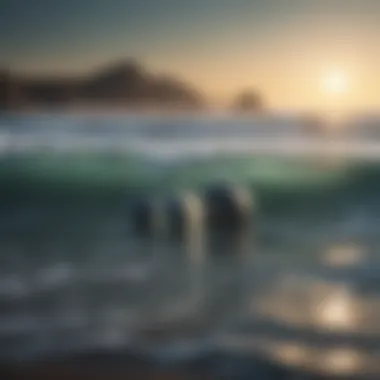
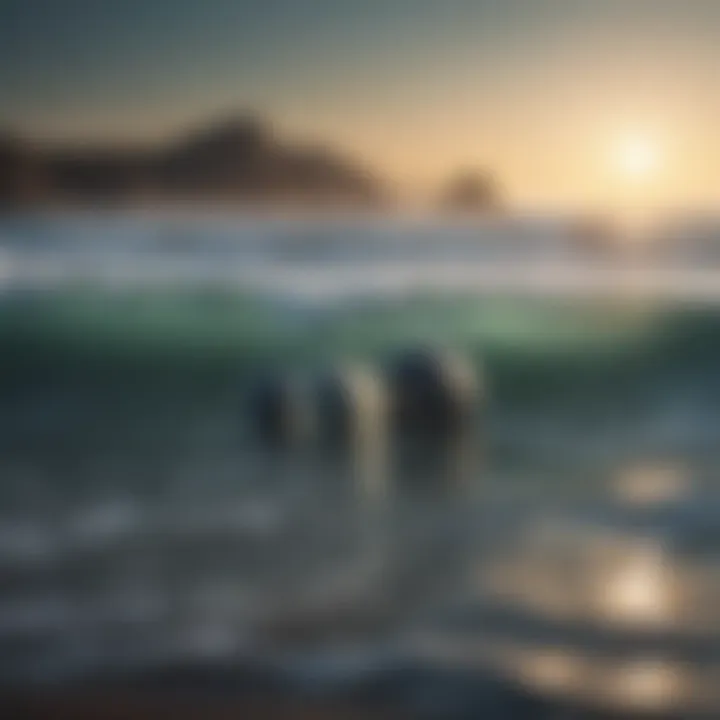
Intro
Surfboarding, a sport that draws many to the thrilling embrace of the ocean, transcends mere physical activity. It’s interwoven with nature's rhythm, particularly the lunar cycle, which plays an unmistakable role in determining surf conditions. The moon pulls at the tides, waxes and wanes, influencing wave dynamics and thereby affecting surfers' experiences in the water. Understanding these lunar phases is crucial for anyone who wishes to harness the full potential of their surfing sessions.
With this guide, we aim to delve into the nuances of the current lunar cycle and its impact on surf conditions. This journey isn’t just about finding the best waves. It includes grasping the mental state that accompanies the ebb and flow of the tides. Every surfer, from novices to seasoned pros, can benefit from knowledge that intertwines lunar insights with surfboarding practices.
The phases of the moon aren’t just astronomical curiosities; they dictate the rhythm of the ocean. Catching a wave isn’t merely about skill or the board under your feet; it’s about riding the cosmic forces that shape the sea. We will explore how these cycles can enhance your experience, offer practical advice, and, importantly, touch on eco-conscious practices that allow us to surf responsibly.
So, let’s get into it.
Surfboarding Techniques
Beginner Tips for Mastering the Basics
If you are new to surfboarding, understanding lunar cycles can be a game changer. Moreover, selecting the right conditions, especially during high or low tides, significantly enhances your chances of catching a decent wave. Here are some tips to get you started:
- Check the tide charts regularly. Know when the high and low tides occur; it can mean the difference between a choppy surf and perfect waves.
- Choose the correct board for your level. Softer boards are typically easier for beginners to handle and provide better buoyancy.
- Positioning matters. Sit far back on your board during paddling to avoid nose diving and practice getting up quickly when catching a wave.
Advanced Techniques for Seasoned Surfers
Once you've mastered the fundamentals, tapping into the lunar calendar can elevate your skills:
- Timing with the tides: Advanced surfers understand how to exploit the peak power of waves during certain lunar phases. For instance, during a full moon, waves may pack more punch.
- Reading the swell: Experienced surfers learn to watch how the moon's position influences wave formation and can adjust accordingly.
- Exploring new spots: Some surf spots come alive with specific lunar phases. Knowing when to venture out can lead to discovering less crowded, high-quality waves.
“A wave is like a song; knowing the right notes influences every move you make.”
Surfboard Equipment
Reviews of the Latest Surfboards on the Market
Selecting the right surfboard can feel like a daunting task with the multitude of choices available. When the moon is full or new, making an informed decision becomes even more essential. The interaction between board design and water conditions changes with lunar activity. Here’s a closer look at a few surfboards that stand out:
- Shortboards: Excellent for high-performance surfing during powerful tidal conditions.
- Longboards: Ideal for catching mellow waves, more forgiving for beginners, especially under calm conditions.
- Fish boards: Perfect for navigating choppy waves during transitional lunar phases.
Essential Gear for Every Surfboarder
Beyond the board itself, having the right gear is paramount. Here’s a concise list:
- Leashes: Ensure you don’t lose your board, especially in rough conditions.
- Wetsuits: Depending on the temperature, necessary for comfort and warmth.
- Wax: Vital for grip, especially when the waves are bigger.
- Surfboard bags: Protect your investment from wear and tear, particularly when transporting it to and from the water.
Understanding how your equipment works in relation to lunar phases can provide significant insights into performance and safety.
By connecting lunar knowledge with each aspect of surfing, newbies, and veterans alike can deepen their love for the sport while respecting the ocean’s rhythms.
Preface to the Lunar Cycle
When one thinks of the lunar cycle, often it drifts to romantic notions or ghost stories whispered under the night sky. However, for surfers, the phases of the moon can be as consequential as the tides themselves. The relationship between the moon and surfing is intricate, influencing everything from wave height to the emotional mood of surfers at the water's edge. By delving into the lunar cycle, surfers can gain an edge, understanding not just when to paddle out but also what conditions to expect based on moon activity.
Defining the Lunar Cycle
At its core, the lunar cycle consists of the progressive phases of the moon as seen from Earth, cycling through roughly 29.5 days. Ranging from the new moon to the full moon and back again, each phase brings along unique tidal behaviors. Surfers have long noted that these shifts in the lunar rhythm can dictate whether beach breaks will be firing or flat.
- New Moon: A phase when the moon is between Earth and the sun, leading to lower tides. This may result in less wave action but provides a clearer opportunity for observation.
- Full Moon: Here, the moon casts its full glow, significantly impacting tides. High tides can lead to intensified waves that many surfers covet.
Getting a handle on the lunar cycle is akin to reading the tea leaves of nature. It's not just about the phase of the moon itself but how it intertwines with oceanic patterns.
Historical Perspectives on the Moon
Throughout history, humans have held the moon in high regard. Ancient mariners used it not just for navigation, but as a calculative tool for predicting ocean behavior. In Hawaii, where surf culture thrives, the moon was deeply integrated into navigating and understanding ocean swells. Surfing was once intertwined with spiritual practices, where certain phases were believed to hold better energies for engaging with the surf.


In many cultures, the moon symbolizes various themes such as change, reflection, and power. These approaches have shifted in modern times, where the empirical understanding of the moon's effects on tides became predominant among surfing communities.
"The tide turns and pulls, much like the innate lure of the moon; it has guided us for centuries and still teaches us today."
Even now, surfboards have been crafted in whispering respect to the ocean, a nod to these historical ties. Understanding how past societies viewed and interacted with lunar cycles allows current surfers to tap into a wealth of knowledge, improving their time on the waves while keeping the legacy of the sport alive.
As we go deeper into this article, the significance of the moon and its phases in surfboarding conditions becomes increasingly clear. For any serious surfer, grappling with lunar influences might be the key to unlocking optimal surfing experiences.
Phases of the Lunar Cycle
The lunar cycle plays a significant role in shaping surf conditions, directly influencing not only tides and waves but also the mental states of surfers. Understanding these phases can elevate your surf experience, enabling to choose the right times for hitting the waves. Each phase of the lunar cycle comes with its unique characteristics and implications that should be analyzed closely.
New Moon
Tidal Patterns
During the new moon, tides reach their lowest and highest points. This phenomenon results in what are known as spring tides, where the gravitational pull from the moon aligns directly with the Earth and sun. The key characteristic here is the dramatic shift in water levels which can expose more surfable areas while reducing others. For surfers, the fluctuations may not only open up new sections of the beach but can also lead to more powerful waves as deeper waters push in. A disadvantage, however, is the potential for currents to become more intense, posing challenges for less experienced surfers navigating unfamiliar surf breaks.
Ideal Surf Conditions
The new moon can create ideal surf conditions, particularly on certain beaches during spring tides. It’s a prime time for early morning sessions when the swells align perfectly with the tide. Surfers find less crowded beaches, as many neglect these conditions, thinking they offer no significant surf. The unique feature of this period? The combination of lesser crowds and prime conditions can lead to an unforgettable experience. But be warned: the strong currents may not be ideal for everyone.
Waxing Crescent
Wave Formation
As the moon begins to wax, it's fascinating to see how wave formation changes. During this phase, the energy from the moon increasingly affects wind patterns, leading to more organized and defined waves. This phase is often characterized by cleaner lines and bigger swells that attract surfers. The key takeaway here is the relationship between the moon’s position and the quality of waves. However, while wave formation may improve, it may also act as a double-edged sword, encouraging more surfers to join in, thus creating busier conditions on popular beaches.
Surf Strategies
With better waves during the waxing crescent, surfers often modify their strategies. Depending on conditions, one might choose to hit lesser-known spots to avoid the crowds. The unique feature of this phase is the excitement it brings to surfers; individuals may experiment more with their techniques, taking advantage of the suitable swell. Though the benefits are clear, it’s essential to keep an eye on safety as more surfers in the water can heighten risks of collisions or accidents.
First Quarter
Tide Variations
The first quarter introduces noticeable tide variations. Water levels are now more consistently manageable, which helps in achieving optimal surf conditions. Noteworthy here is that the tidal pull results in balanced conditions that often yield excellent waves. This steady state makes it favorable for surfers to plan their outings, allowing them to anticipate when the water will be just right. The downside, however, could be that familiar spots might get crowded.
Impact on Surf Sessions
During this phase, surf sessions can be more predictable and conducive for various skill levels. Novice surfers may find it easier to navigate the waters, while veterans can refine their techniques. What stands out during this phase is the regularity of sessions that can be scheduled, making this phase popular among local surf communities. In contrast, unpredictability in surf conditions can be just around the corner, hinting at the ever-changing nature of the waves.
Waxing Gibbous
Increasing Energy
As the moon approaches full illumination, energy levels rise not just in natural phenomena but for surfers too. The waxing gibbous phase often contributes to more consistent and dynamic wave patterns. One advantage of higher energy waves during this phase is the ability to capture higher tides necessary for specific surf breaks that thrive under such conditions. However, stronger waves can also intimidate newer surfers, suggesting careful consideration before paddling out.
Surfline Predictions
This phase remains essential for utilizing platforms such as Surfline that offer real-time conditions. Being more informed leads to smarter choices. The predictions during this phase can make or break a surf session. A unique feature includes the ability to prepare for peak moments — knowing when to surf for optimal conditions is invaluable. But misinterpreting charts can lead to poor decisions, especially under changing tide conditions.
Full Moon
Heightened Tides
Under the full moon, heightened tides occur, which can lead to surfing conditions that are both exhilarating and challenging. The gravitational pull is at its peak, causing tides to swell to significant heights. Surfers must navigate the line between thrilling surf and potential hazards. Enthusiasts often harness this energy for powerful rides. However, caution is necessary, as the increased tide changes the landscape of familiar surf spots, sometimes leading to unpredictable currents.
Safety Considerations
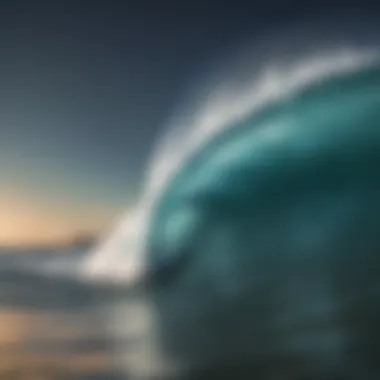
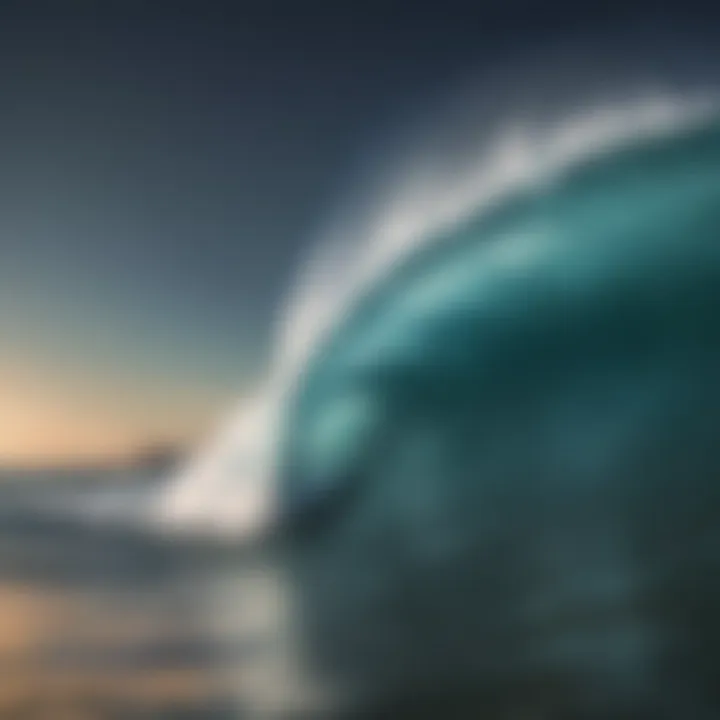
Safety during a full moon phase deserves attention. While the thrill of enhanced swells is enticing, deeper waters rushed by heightened tides can create treacherous conditions. Surfers should remain vigilant and respect their limitations. Unique feature? Aligning moonlit nights can create breathtaking surf experiences, yet it’s vital to know when to call it a day. The balance between awe and danger is pivotal.
Waning Gibbous
Post-Full Moon Effects
After the full moon, the waves and tides start to settle. But the post-full moon effects shouldn't be underestimated. The water may still harbor residual energy that can produce consistent surf. The key characteristic during this phase is the gradual decline of these elevated conditions, which may yield good surf, without the intensity levels of just days prior. Here, surfers can still enjoy excellent rides but must recognize the declining trend in conditions.
Wave Analysis
Wave analysis during the waning gibbous becomes non-negotiable for surfers looking to maximize their time. Understanding changes can lead to great sessions. Analyzing data from previous sessions alongside current conditions provides insight into the nature of the waves. This phase allows surfers to hone their skills further, but it’s essential to notice the slow transition; improvements might not come as easily as in earlier phases.
Last Quarter
Transitioning Tides
With last quarter, transitioning tides are back in play. Surfers often face the ebb and flow of dynamic conditions; it creates a semi-stable environment where both waves and tides adjust their rhythm. Surfers might find it unpredictable yet rewarding, as they can discover new breaks previously unnoticed during higher tides. An intriguing aspect of this phase is the ability to test gear in various conditions, allowing surfers to adapt their skills.
Consistent Surfing Conditions
Over the last quarter, surfers may engage in more consistent conditions which allows lessons learned to translate into tangible improvements. Those looking to sharpen their skills will find that these conditions usually provide an excellent space for practice. However, keeping in mind the gradual transition means that surfers should always be prepared to adapt. This phase is perfect for reflecting on personal technique and strategy, ensuring that every ride counts.
Waning Crescent
Lunar Cycle Reflections
The waning crescent carries with it a moment of reflection for surfers. It often brings smooth, calm waters making it a wonderful time for beginners to hone their skills or even practice paddle techniques in a less crowded sea. The key characteristic is the serene atmosphere that often accompanies the end of the lunar cycle. This phase offers valuable lessons — surfers should take the time to consider what they learned over the previous month.
Evaluation of Conditions
Finally, evaluating conditions during the waning crescent phase is vital. Surf reports can highlight where changes may occur, helping surfers understand conditions leading into the new cycle. Taking stock of one’s experiences, both triumphant and challenging, can lead to more fruitful surf days ahead. Emphasizing growth and preparation offers unmatched advantages as another cycle begins.
The Science Behind Lunar Influence
Understanding the lunar cycle is crucial for surfers because it unveils the physical principles behind tides and waves. The moon's gravitational pull is more than just a celestial phenomenon; it has direct effects on water movement, thus influencing surfing conditions. The connection between the moon's phases and ocean behavior helps surfers make informed decisions about when to hit the waves. Being in tune with these dynamics can lead to both performance improvement and enhanced experiences on the water.
Gravitational Effects on Tides
The gravitational force exerted by the moon is the primary reason we get tides. When the moon is overhead, its pull creates a bulge in ocean water, leading to a high tide. Conversely, on the opposite side of Earth, another high tide occurs due to the centrifugal force caused by the Earth-moon system's rotation.
In simple terms, whenever there’s the full moon or new moon, these tides often become more pronounced. This means that tidal ranges—the difference between high tide and low tide—expand significantly. Surfers should keep this fluctuation in mind, as it can alter their expected conditions drastically. For instance, dropping tide may uncover reef breaks that were earlier submerged, creating ideal surfable waves.
It’s critical for surfers to understand this connection. A keen awareness of when high and low tides occur can aid in selecting spots that are more favorable for riding. There’s an intricate dance between the moon and the sea that shapes the experience of every wave caught.
"Timing your surf session with the tides is like hitting a sweet spot; you'll ride waves that are just right for you."
Correlation Between Lunar Phases and Wave Behavior
Different lunar phases have distinct effects on wave patterns, influencing surf conditions in ways that go beyond tidal changes. For instance, during the waxing phases, such as the waxing gibbous, waves often build in intensity. This is because the increased gravitational pull from the moon can lead to larger, swellier waves ideal for more aggressive surfing. Conversely, as the moon wanes, particularly in the waning gibbous and last quarter phases, the energy and consistency of the waves generally tend to fluctuate.
Surfers often notice variations in how wave energy interacts with local coastal features during these changes. Similarly, the pull of the moon and the shifting tides can enhance or diminish factors like wind conditions, which also contribute to surf quality.
This correlation has prompted many experienced surfers to develop personal calendars. Such records help them predict better surfing days by tracking the moon phases and waves over time. Spotting these patterns can transform the surfing experience, enabling surfers to align their trips with optimal wave conditions, thus making the most of their time in the water.
Surfing is not just a sport; it's an ongoing conversation with nature, and the lunar cycle is an influential voice in that dialogue. With this understanding, one can harness the moon's rhythm to enhance surfing proficiency and overall experience.
Practical Applications for Surfers
When it comes to riding the waves, understanding the lunar cycle offers surfers a unique advantage that goes beyond mere water skills. Knowing how the moon influences tides and wave conditions can help surfers plan their trips effectively. Instead of just chasing the swell on a whim, they can harness the power of lunar fluctuations to find prime surfing moments.
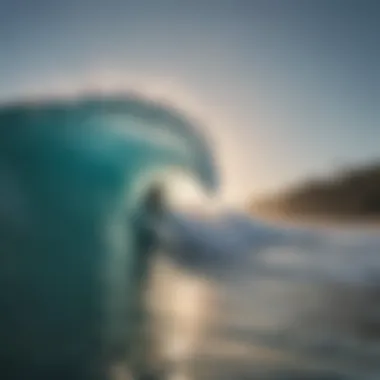
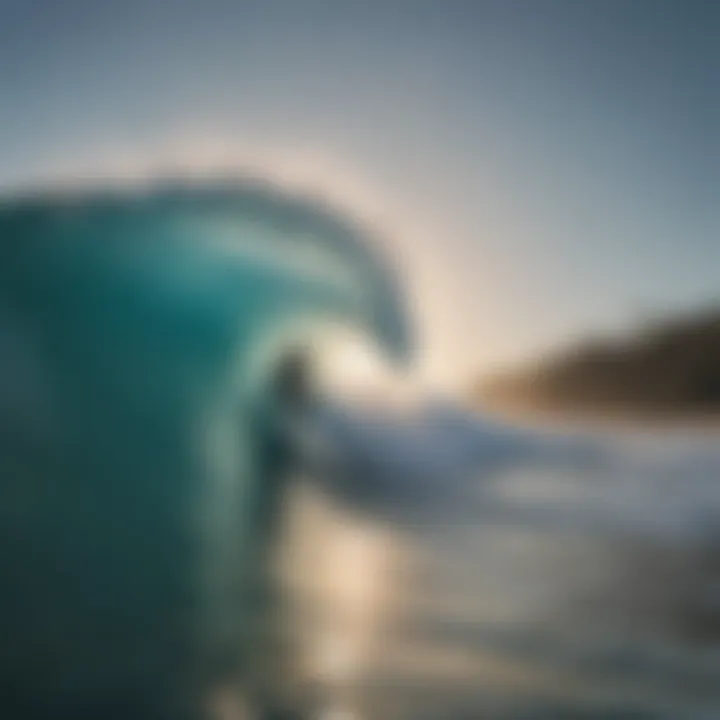
Tracking the Lunar Cycle
Tracking the lunar cycle is akin to keeping an eye on the clock, but for the ocean. By understanding the different phases of the moon, surfers can predict tidal changes and their effects on surf conditions. The cycle can be tracked using various apps or websites designed for enthusiasts and pros alike. Using an app like the "Surfline" or checking Tide Charts can prove invaluable. It’s like having a cheat sheet for the ocean.
- New Moon: Provides specific conditions that create consistent waves, ideal for surfers.
- Full Moon: Often leads to bigger tides which can drastically change the surf landscape.
Once a surfer becomes adept at tracking these patterns, they can anticipate when to hit the beach. It’s not just about being there; it’s about being there at the right time. This understanding could mean the difference between a drifty session or catching that perfect wave.
Using Lunar Patterns to Optimize Surf Trips
Utilizing lunar patterns isn’t just for local surfers; it can also optimize surf trips far from home. Advanced planning can turn a weekend getaway into a trip that maximizes wave time, and lunar cycles tell how high or low the tides will be at a particular spot.
Here are some considerations for maximizing a surf trip based on lunar influences:
- Choosing Locations: Some beaches respond better to specific lunar phases. For instance, you might find that a particularly reef-heavy area has more reliable waves during a waxing gibbous.
- Timing the Sessions: The best times to surf often align with specific lunar events such as spring tides, which occur after the new and full moons. Knowing this means you won't waste a precious surf window.
- Avoiding Crowds: By planning your trip around even less popular lunar phases, surfers can dodge the crowds that come out during optimal conditions.
"The moon doesn’t just light the night sky; it can light the path to your best surf!"
Eco-conscious Practices in Surfboarding
As the tides shift, so too must our approach to surfing. Nowadays, eco-conscious practices in surfboarding are not just the trendy talk at the beach bonfire; they represent a vital movement toward sustaining our oceans and enriching our surf culture. With the ever-growing concern for the environment, surfers now find themselves at a crossroads between their passion for the waves and the impact of their activities on marine ecosystems.
Noticing how different lunar phases affect our surf spots, it's also crucial to consider their role in shaping our eco-friendly choices. Here are some specific elements that underscore the importance of eco-conscious surfing practices:
- Environmental Preservation: Every time a surfer paddles out, there's a potential impact on marine life. Being mindful about the gear we use can help reduce plastic waste in these beautiful waters. Choosing equipment made from sustainable materials can lessen our footprint and help preserve delicate ecosystems.
- Awareness of Tides: Understanding tidal patterns not only affects surfing conditions but shows a deeper respect for nature. By syncing our surf sessions with the lunar cycle, we align ourselves with the rhythms of the ocean, fostering a connection that encourages responsibility toward our aquatic environment.
- Educating Others: Engaging with fellow surfers about sustainable practices raises awareness. Sharing knowledge during a surf trip or localized community event can amplify positive changes, ensuring more wave-riders understand their influence on the sea.
The benefits gained from these practices are multifaceted, encompassing environmental, social, and personal gains. For the oceans, this means healthier marine habitats. For the surfing community, this shifts perceptions, ultimately enriching the surf culture.
Sustainable Surfing during Varied Lunar Phases
Believing that the moon affects just tides is a common misunderstanding among surfers. In reality, the influence extends to the sustainability of our surf practices as well. Recognizing how varied lunar phases impact ocean dynamics can guide surfers in making sustainable choices.
- New Moon: With lower tides, it’s essential to stay off sensitive habitats like sea grass beds and coral during adventures, allowing them to thrive undisturbed.
- Full Moon: Higher tides often lead to increased coastal erosion. This is an ideal time for surfers to opt for protective actions, such as picking up trash at the beach or promoting no-wake zones.
Incorporating sustainability into your routine isn’t just good for the environment; it enhances your surf experience, too. You'll find joy and fulfillment from knowing you are protecting the waters you love.
Community Engagement and Moon-related Events
Strengthening connections within the surf community offers an avenue for fostering eco-conscious practices. This can take the form of moon-related events that celebrate our bond with the lunar cycle while promoting sustainability.
Consider organizing or participating in:
- Beach Cleanups: Pick a lunar date, preferably one aligning with the new or full moon, to rally fellow surfers for a beach clean-up. The collective effort not only nurtures the coastline but also builds stronger camaraderie.
- Full Moon Surf Gatherings: Hold themed surf gatherings under the light of the full moon. These can serve as inspiration for discussions about ocean health, sharing sustainable tips, or even building a community library of eco-conscious surf gear.
"The ocean is a dance floor of nature. As surfers, our moves can either create harmony or discord—let’s choose wisely."
Engagement can transcend the surface. When surfers come together to honor the moon’s influence on our waves, they simultaneously cultivate a culture of sustainability and awareness. This fusion not only preserves our treasured surf spots but rewards us and future generations with blissful rides ahead.
The End: The Integral Role of the Lunar Cycle in Surf Culture
As we draw the curtain on this exploration of the lunar cycle's impact on surf culture, it becomes clear that the moon is more than just a celestial body glowing in the night sky. It's a dynamic force that shapes the rhythm of our tides, influences wave behavior, and even molds the mindset of surfers. Understanding this intricate relationship enhances not only the surfing experience but also deepens the appreciation for the natural world governing our waters.
Reflecting on Connections to Surfing
The connection between surfboarding and the lunar cycle runs deep, traversing both physical conditions and the emotional landscape of those in the water. Surfers often find themselves tethered to the moon's phases; each one brings its own set of conditions that can either enhance or hinder the surf experience. For instance, during the full moon, heightened tides can create powerful swells, often attracting surfers eager for bigger waves. Conversely, periods like the waning crescent might signal calmer waters.
Moreover, this cyclical relationship fosters a community among surfers. Sharing tips on the best times to catch waves during different lunar phases becomes second nature. Discussions and planning often revolve around the moon's position, making the lunar cycle an integral topic of conversation among avid surfers. It’s almost as if the moon is part of the crew, guiding adventures and challenging participants to adapt their techniques according to its phases.
Future Considerations and Trends
Looking ahead, the relationship between surf culture and the lunar cycle is poised for evolution. As more surfers turn to technology for assistance, apps and gadgets tailored to track lunar phases, tides, and surf conditions are on the rise. Innovators are crafting devices that not only help predict ideal surf times but also educate users on how lunar influences affect oceanic patterns. This trend blends tradition with modernity, ensuring that ancient knowledge has a place in today’s digital world.
In addition, growing awareness around sustainability means that surfers will increasingly factor in the environmental impact of their practices. As the moon's cycles often dictate tidal movements essential for maintaining marine ecosystems, there’s a potential for greater advocacy around preserving ocean health. Initiatives that engage local communities with lunar-themed events, like shoreline clean-ups tied to specific lunar dates, can forge stronger ties between surfing and ecological responsibility.
In summary, the intricate dance of the lunar cycle within surf culture encapsulates a unique blend of physics, passion, and community spirit. It prompts us to ponder how a simple astronomical phenomenon can hold such significance over our tide-driven pursuits. The surf world continues to adapt and respond, intertwining age-old wisdom with modern practices, as we all ride the waves of the ever-turning lunar cycles.















